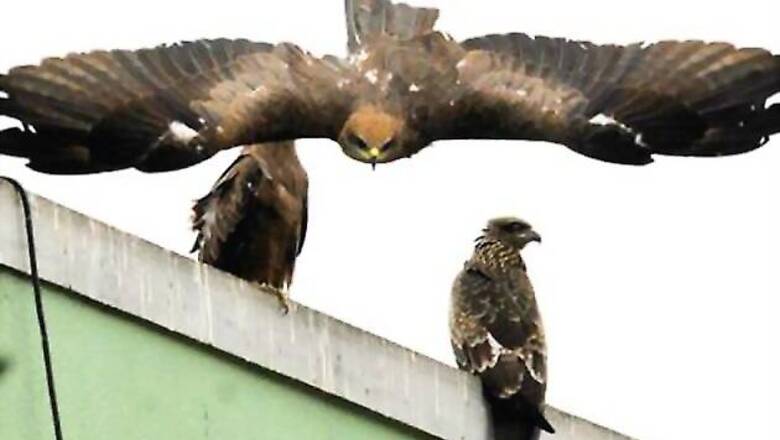
views
Bangalore: Popularly known as Black Kites and formerly as Pariah kites, the Milvus migrans is today a creature of the urban milieu, swooping and hovering over dead carcasses and inedible animal parts and inhabiting the densely populated areas of the city which has a high concentration of slaughterhouses, butcher shops and meat markets. A bird of the urban landscape, the Pariah Kites are basically scavengers, feeding mainly on carnivorous food.
Once, they used to feed on small birds, rats and frogs but now they have adapted to feeding on the leftovers and remains of animal carcasses that are strewn indiscriminately near meat shops or dumped at sewage outlets at many places in the city. The dumping yards of K R Market, Vrishbavathy valley, Peenya region, Kumbalgod to Mekadatu are the hunting grounds for these birds but in the process, they are falling prey to contaminated food, laced with chemicals and pesticides.
Most meat shops in the city dump the unpalatable, internal organs like intestines of goat, sheep, cow, pig and predominantly, the head and feathers of birds like hen. Dead animals and their organs are an ideal medium for bacterial growth. Slaughterhouse wastes like blood, bone, and viscera, as well as remains of euthanised cats and dogs passed along by veterinarians and animal shelters, or those meeting a terrible end on highways have found themselves to be the perfect meal for these naive but helpless kites.
Apart from this, the sewage water that flows from one end of the city to the other is also laced with these dumpings which inordinately attracts these scavengers in hordes but feeding on this junk, the birds tend to consume other poisonous waste material.
Wildlife biologists say, “Omnivores by nature, they eat anything whether inedible or poisonous and everyone feels they are adaptable and nothing will happen to them but the sight of many of them sitting on wires, poles and buildings of the city, looking frail, delicate and diseased belies this notion totally.”
Speaking to City Express, Compassion Unlimited Plus Action (CUPA) Manager, T Ramesh said, “The junk that is indiscriminately thrown in the city has been killing the Black Kite population over the years. The kites flying over the landscape pick up everything that is dumped under their eagle eyes, resulting in disease and death. The inedible innards of the animal which are totally contaminated are consumed by these scavengers. No organised study has been done by the Wildlife authorities or even wildlife groups as according to International Union of Conservation and Nature (IUCN), there is a good population and therefore, not added it to the endangered list."
"However, seeing the prevailing condition, there is definitely a need for scientific study on the decreasing population of kites in Bangalore,” says Ramesh and adds, “There is no specific count method to determine its population and it will be a herculean task for anybody to proceed in its absence.”
Most of the birds face other problems like intense heat and lack of food and this intensifies and multiplies in the breeding season. “We get 7 to 8 kites every day at the BBMP Veterinary Centre.90 per cent of them are suffering from dehydration and other reasons. We feed them for a period of one week and then release them in the wild,” says Sharat Babu, Wildlife Warden, BBMP. He further said sick or injured birds are administered first aid and later rushed to WRRC, Bannerghata for further treatment.
Like other birds, Kites too face the problem of being killed by hired bird watchers over flying zones in the city. Some time ago, an incident of black kites being shot over the HAL Airport boundary was reported although officials denied it. In fact, the BBMP Wildlife Wing had to rush two bleeding kites for treatment as bird-watchers employed by this defence organisation had shot these birds instead of scaring them away.
Unless and until, a proper study is done by the wildlife authorities to ascertain their dwindling number as well as the consequences on their health, the time is not far off when the kites too may join the endangered list in the coming years.
Brown beauties
Milvus migrans govinda (Small Indian Kite) is found in Eastern Pakistan region through tropical India and Sri Lanka to Indochina and Malay Peninsula. This dark brown kite is in fact, found throughout the subcontinent.
In India, the population of sub-species Govinda is particularly large, in areas of high human population. Only once a survey was done, in 1967 in the 150 square kilometers of the city of New Delhi that revealed an estimate of about 2,200 pairs or roughly 15 kites per square kilometer.




















Comments
0 comment